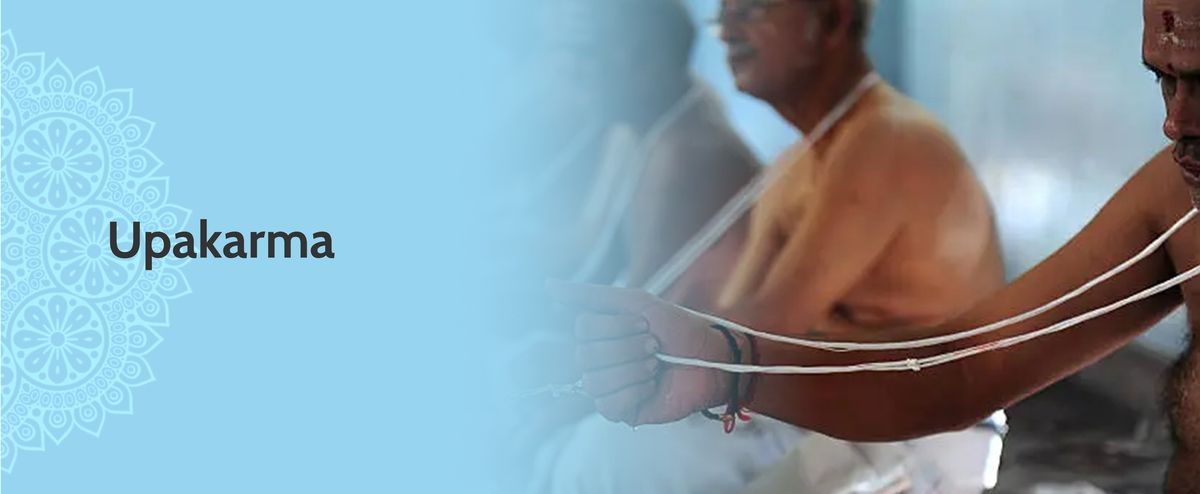upakarma


Sanatana Dharma is one of the oldest religions in the world, and as everyone knows, it is rich in tradition and rituals. One of the most important annual rituals observed by Hindu Brahmins is the Upakarma ritual. Upa is a Sanskrit prefix that means before, or upfront. Karma as everyone knows means action. So Upakarma is a ceremony that is performed before the start of a new academic year for the Brahmin community, during which they study the vedas.




This ceremony usually takes place in the Hindu month of Shravana (Tamil month of Avani). However, the exact day varies according to the sect one belongs to. Those that follow Yajur Veda perform their rituals on the full moon of the Shravana month, while Samavedis perform theirs on the third day after the next new moon. Interestingly, in most years Dhanistha will be the star on this day! The main event of this ceremony is the changing of the sacred thread, called Janeyu or Yagnopaveeta by Brahmins. All activities of the day form part of the Upakarma Homam. The new thread is sanctified with mantras and prayers and it is worn around the left shoulder and under the right arm. The next day, is day one of the new ‘academic year’ and begins with the Brahmins reciting the powerful and sacred Gayatri mantra, sometimes alongside a homam or Havan, at least 1008 times as a precursor to the commencement of Vedic studies.
This homam, as any other involves the participants, dressed in traditional vastram, sat around a sacred fire. Offerings of ghee and medicinal twigs are offered into the fire.
In the early days, male members of the Brahmin community began their Vedic studies from the day following the Upakarma, and took a pause after 6 months, towards the end of the lunar calendar. However, it soon became obvious that six months was just not adequate to perform a detailed study of the Vedas. Consequently, they continued their studies, without the pause as prescribed by the scriptures. The Upakarma ritual is actually performed to ask pardon for this transgression, where the old thread is discarded and a new, sanctified one is worn in preparation for the next study period.




Any Hindu will know there is always a legend associated with every ritual. Here’s goes the legend for this one. It is believed that Lord MahaVishnu created Lord Brahma from his naval and imparted the entire knowledge within the Vedas to him. Madhu and Kaitabha, two demons born from the earwax of Lord MahaVishnu got drunk with their invincibility and stole the Vedas from Brahma while he was deep in meditation. Legend has it that acceding Brahma’s plea, MahaVishnu took the form of Hayagriva and fought the demons to retrieve the Vedas on this day. Therefore it is commemorated by the rituals to start Vedic studies.
In southern India, this festival is also called Avani Avittam. Avani referring to the month that this ritual takes place in, and avittam being the Tamil name for the star Dhanishta. Although it bears this name, it is not always that the ritual occurs at this time, and hence is a misleading name for the Upakarma ritual. The reason for this is that the event is celebrated as per the Lunar calendar and not Solar calendar of Tamil (Avani). The solar month follows the Masa Pirappu and is generally from middle of the month and is around 30 / 32 days, whereas lunar calendar follows Amavasai and a month is 27 and one quarter day. Given this cycle in some years Sravana pournami can also fall in thea previous Tamil month called Adi depending on the number of days within solar start of the month Amavasai follows! There – now you know it.a


When Masa Pirappu and Amavasai are separated by by 14/15 days, which is probably occurs every 4th year, then Sravana pournami will fall in Avani month. Nakshatram is not a criterion, but invariably it will be Thiruvonam or Avittam.
In 2023, in the UK Yajur Upakarma falls on August 30th .


